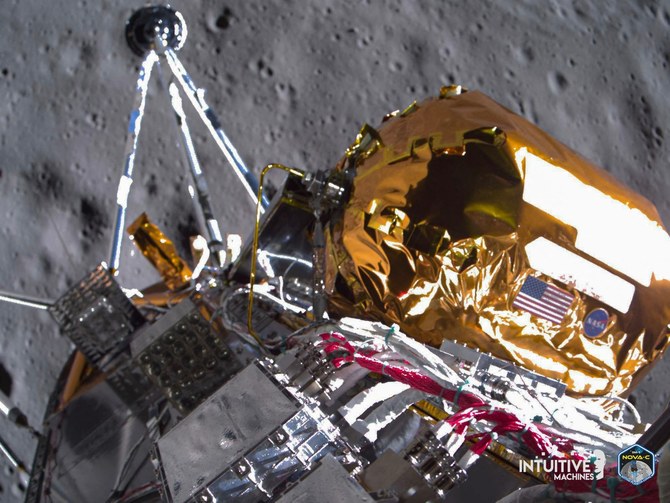
- ARAB NEWS
- 18 Jul 2025

Intuitive Machines’ Odysseus moon lander on Wednesday sent the first pictures of its moon landing to ground control, despite having faced a challenging touchdown a few days earlier. The images of its approach and of the lunar surface are part of a historic moment in space exploration.
The lander, part of NASA’s Commercial Lunar Payload Services program, faced initial communication issues. And, while some mission components suffered setbacks, Odysseus touched down the farthest south a vehicle has ever landed on the moon, opening great new possibilities for lunar exploration. As we all know, exploration in space is hard and the lander will cut short its mission due to its sideways landing.
A day prior to these first images sent by Odysseus, Japan’s own first moon lander, the Smart Lander for Investigating Moon, known as SLIM, responded to a signal from Earth, suggesting it had survived a second lunar night (which lasts about 14 days). This was considered a “miracle” by JAXA, the Japanese space agency. The SLIM probe made a precise touchdown last month, making Japan the fifth country to successfully place a probe on the moon. Despite initial setbacks with solar panels and battery power, the mission achieved its primary goal, landing within a 100-meter target zone. This landing has opened up new possibilities regarding the technology employed for the future exploration of lunar resources like fuel, water and oxygen.
Another few days earlier, China’s space agency, the China Manned Space Agency, revealed the names of the spacecraft for its next lunar mission, including the Mengzhou (Dream Vessel) spaceship, Lanyue (Embracing the Moon) lunar lander and the Long March 10 super heavy-lift carrier rocket.
Competition for the establishment of settlements on the moon has heated up in recent years
Khaled Abou Zahr
This ambitious program aims to send Chinese astronauts to the moon by the end of the decade, which would make it the second country to achieve this feat. The Mengzhou spacecraft comprises a reentry module and a service module, while the Lanyue lunar lander will accommodate two astronauts and a rover. China’s recent achievements include the unmanned Chang’e missions and it has plans for a permanent lunar research station by 2040. This comes after a Chinese spacecraft in 2019 successfully landed on the moon’s far side and sent pictures back home. China’s Chang’e-4 spacecraft accomplished this global first.
Competition for the establishment of settlements on the moon has heated up in recent years, especially between the US and China. Both countries’ missions align with global interest in space exploration for scientific, prestige and resource-related reasons.
The US’ Artemis missions are on the way, with Artemis 1 having already completed its mission by circling the moon with mannequins on board in late 2022. Artemis 2 is expected to follow a similar trajectory, carrying four astronauts, with a tentative launch date of no earlier than September 2025. Artemis 3, scheduled to land on the lunar surface in 2026, is contingent on successful execution, although both Artemis 2 and 3 have faced delays due to various technical challenges.
Before this week’s success, the US had been absent from the surface of the moon since 1972 and the final Apollo mission. However, this return bore an important difference to the previous space epoch: it was the first time a private company had landed on the moon. While previous missions were always led by NASA, this time we have a new model that opens the door to the commercialization of space opportunities. This new model started with Elon Musk’s SpaceX and was initiated by the US.
This time we have a new model that opens the door to the commercialization of space opportunities
Khaled Abou Zahr
Main contender China, on the other hand, has so far chosen to use the old government model that the US and Soviet Union used while competing in space. However, this new epoch has, with the goal of future settlements on the moon in mind, brought potential economic opportunities that were unforeseen until now. It is still in its early days but this development can be a true booster for the global economy. There is no doubt that the US model that empowers the dynamism of the private sector is the right way to go about seizing this opportunity in the most efficient way.
This future lunar opportunity might today be considered an add-on to the already burgeoning low Earth orbit economy, which has seen new companies appear with the promise of becoming prime players, just as the aerospace or the automotive industries did in the past. Yet, while the number of private satellites around Earth has exponentially increased and will continue to do so in the coming years, they have also become a potential target in any future direct military confrontation. This is why intelligence on Russia’s development of an anti-satellite nuclear weapon has been taken seriously.
With this new window of growth, there is little chance that space will continue to be an area of collaboration between countries, especially as it is no longer only about scientific discovery and projecting technological superiority, but of developing commercial and economic benefits. This is also why international agencies such as the UN, through the Office for Outer Space Affairs, are looking to regulate the space domain, especially the expected highway to the moon. However, with the UN’s difficulties in imposing rules on Earth, there is little hope it can keep up in space, putting at risk the 1967 Outer Space Treaty that guarantees the peaceful use of space.
For now, the main obstacle to direct sabotage or confrontation is the difficulty of space. Yet, with maturing technologies and new dominance, this might all change. When the International Space Station’s lifespan comes to an end in 2031, the competition for space and potential new resources will be at its peak. Or it will be no more. Good old Earth politics still has to give its verdict.